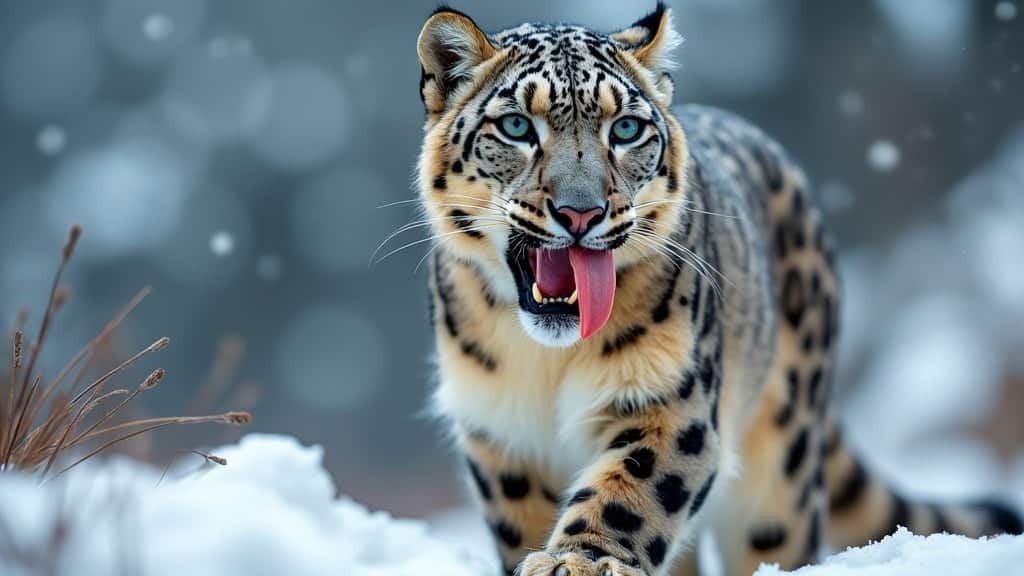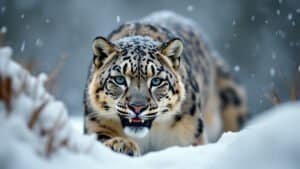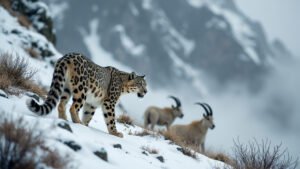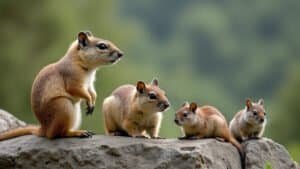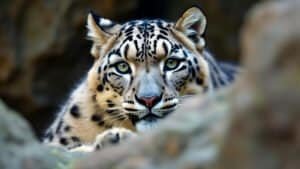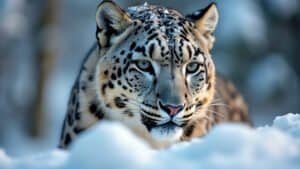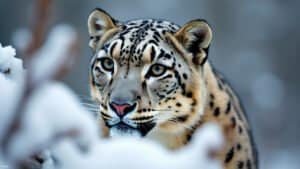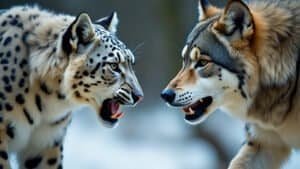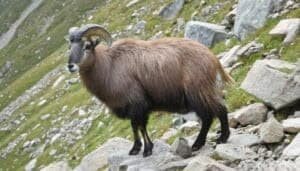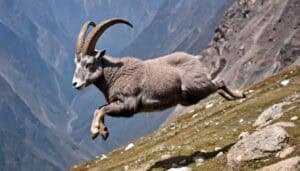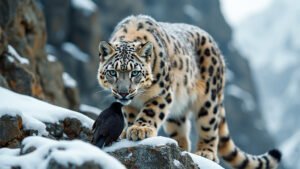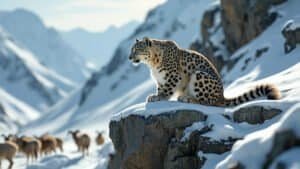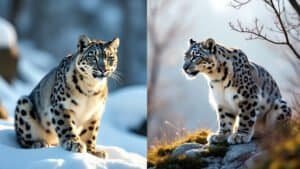Introduction
Snow leopards, elusive big cats native to the rugged mountains of Central and South Asia, have unique dietary needs that are crucial for their survival in harsh environments
This article explores how much food a snow leopard typically consumes in a day, examining its daily calorie intake, hunting frequency, and prey preferences. We will also delve into how environmental factors and seasonal changes influence its diet, and how its feeding habits compare to other big cats. Understanding these factors provides insight into the survival strategies of this majestic predator
How Much Food Does a Snow Leopard Eat Daily?
Snow leopards, known scientifically as Panthera uncia, are apex predators that inhabit some of the most remote and rugged terrains on Earth. These solitary cats are primarily found in the mountainous regions of Central and South Asia, including the Himalayas, the Tibetan Plateau, and the Altai Mountains
Their diet is heavily influenced by the scarcity of prey in these harsh environments, requiring them to be efficient hunters and consumers. Understanding how much food a snow leopard consumes daily is crucial to grasping its survival strategies and ecological role
Typical Daily Calorie Intake
A snow leopard typically requires between 2,000 and 4,000 calories per day to maintain its energy levels, although this can vary depending on factors such as age, sex, and activity level. For comparison, an adult human’s daily calorie intake is recommended to be around 2,000 calories
Given that a snow leopard’s prey often consists of large mammals, the caloric content of their meals is high. For example, a single large prey animal, like a blue sheep or ibex, can provide enough sustenance for a snow leopard for several days. These animals can weigh between 50 to 150 pounds, offering a significant caloric boost to the predator
However, the energy expended in hunting these large animals is also considerable. Snow leopards often navigate steep, rocky terrains and may pursue prey over long distances, which increases their caloric needs. Juveniles and lactating females typically require more calories than adult males due to their additional energy demands
Frequency of Hunts
Snow leopards do not hunt daily. Instead, they engage in periodic hunts, with the frequency largely depending on the success of previous kills. On average, a snow leopard may successfully hunt and kill a large prey animal every 8 to 10 days. After a successful hunt, the snow leopard can consume up to 20 pounds of meat in one sitting, though they typically eat around 10 to 15 pounds
After a large kill, a snow leopard may return to the carcass multiple times over several days, covering it with snow or dirt to protect it from scavengers and to preserve it in the cold environment. This strategy allows the snow leopard to sustain itself over longer periods without the need to hunt frequently
Common Prey in a Snow Leopard’s Diet
The diet of a snow leopard primarily consists of wild ungulates such as blue sheep (Pseudois nayaur), Siberian ibex (Capra sibirica), and Argali sheep (Ovis ammon). These large herbivores provide a substantial amount of meat and are critical to the snow leopard’s diet
In regions where these animals are scarce, snow leopards may also prey on smaller mammals such as marmots, hares, and birds. In some cases, they may hunt domestic livestock, which often leads to conflict with local herders
The selection of prey is closely tied to the availability of these animals in the snow leopard’s territory. The ability to take down large prey allows snow leopards to maximize their caloric intake while minimizing the frequency of hunts, a crucial adaptation in their energy-limited environment
Seasonal Variations in Diet
Seasonal changes significantly impact the snow leopard’s diet. During the harsh winter months, when prey animals migrate to lower altitudes or become less accessible due to snow cover, snow leopards might hunt smaller prey more frequently. In contrast, during the summer, when larger prey is more abundant at higher altitudes, they tend to target these animals more often
Moreover, the snow leopard’s solitary nature and large territorial range, which can extend up to 500 square miles, means that they may traverse vast areas to find food, especially in winter when prey is scarce. This seasonal variation in diet highlights the snow leopard’s adaptability and resilience in its harsh, mountainous habitat
Snow Leopard Hunting and Feeding Behavior
Snow leopards are remarkable predators, uniquely adapted to the rugged and remote mountain environments of Central and South Asia. Their hunting and feeding behaviors are shaped by the challenges of their habitat, which includes steep, rocky terrain, and a scarcity of prey
These behaviors are crucial for the snow leopard’s survival and offer fascinating insights into their role as apex predators in one of the world’s most inhospitable landscapes
Hunting Techniques and Strategies
Snow leopards are stealthy hunters, relying on a combination of patience, camouflage, and agility to capture their prey. Their spotted, pale fur provides excellent camouflage against the rocky, snow-covered landscapes where they live. This allows them to stalk their prey closely before launching a swift and powerful attack
Typically, a snow leopard will stalk its prey from above, using the natural cover of rocks and cliffs to remain undetected. Once within striking distance, it will leap, using its powerful hind legs to propel itself towards the prey
Snow leopards are known for their incredible leaping ability, capable of jumping up to 30 feet in a single bound. This agility is essential for catching fast and often sure-footed prey like ibex and blue sheep on steep mountain slopes
The attack is usually directed at the neck or throat, delivering a fatal bite. However, not every hunt is successful. Snow leopards may need to spend hours or even days stalking a single animal, and the rugged terrain often allows prey to escape. These failed hunts mean that when a snow leopard does succeed, it needs to maximize the caloric intake from its kill
Prey Capture and Consumption
Once a snow leopard has successfully killed its prey, the feeding process begins. These big cats are solitary feeders, rarely sharing their meals except with their cubs. After making the kill, the snow leopard will drag the carcass to a secluded area, often up to 200 feet away, to avoid detection by scavengers and other predators
A snow leopard can consume a significant portion of the carcass in one sitting, eating up to 20 pounds of meat, though more typical consumption is around 10 to 15 pounds
They start by eating the internal organs, which are rich in nutrients, before moving on to the muscle tissue. The snow leopard’s powerful jaws and sharp teeth allow it to tear through tough hide and sinew, enabling it to consume as much of the carcass as possible
Given the scarcity of food in their environment, snow leopards are not wasteful eaters. They will consume as much of the carcass as possible, returning to it over several days until only bones remain. This ability to efficiently utilize a single kill is critical for their survival, as hunting opportunities can be infrequent
Food Storage and Conservation Methods
Snow leopards have developed unique methods for conserving food, allowing them to survive in environments where prey is not abundant
After a successful kill, if the snow leopard cannot consume the entire carcass at once, it will often cover the remains with snow, dirt, or rocks. This behavior, known as caching, helps to hide the carcass from scavengers like vultures, foxes, and other predators
The cold temperatures in the snow leopard’s habitat act as a natural refrigerator, helping to preserve the meat for several days. The snow leopard will return to the cached carcass multiple times, feeding on it until nothing edible remains. This strategy minimizes the need for frequent hunts and helps the snow leopard maintain its energy balance in an environment where food can be scarce
Challenges in Securing Food in the Wild
Securing food is one of the greatest challenges for snow leopards, largely due to the harsh and unpredictable nature of their mountainous habitat
Prey animals are often few and far between, and the rugged terrain can make both hunting and finding food difficult. Additionally, snow leopards face competition from other predators, such as wolves and large birds of prey, which can also target their kills
Human activities pose another significant challenge. In some regions, snow leopards come into conflict with livestock herders, leading to retaliatory killings when snow leopards prey on domestic animals. Habitat loss due to expanding human settlements and climate change further exacerbates these challenges, making it increasingly difficult for snow leopards to find enough food
The Impact of Environment on Snow Leopard Diet
The snow leopard’s diet is heavily influenced by its environment, which includes some of the most extreme and rugged terrains in the world
These elusive cats inhabit high-altitude regions of Central and South Asia, where the landscape, climate, and availability of prey all play a crucial role in shaping their feeding habits. Understanding how these environmental factors impact their diet is essential for conservation efforts and for understanding the ecological role of snow leopards in their natural habitats
Variations by Geographic Location
Snow leopards are found across a vast range that includes 12 countries, from Afghanistan in the west to China and Mongolia in the east. The specific prey available to snow leopards varies by region, leading to differences in diet based on geographic location
In the Himalayas, for example, blue sheep (also known as bharal) and Himalayan tahr are the primary prey, while in the Altai Mountains of Mongolia, the Siberian ibex and Argali sheep are more common
In regions where large ungulates are less abundant, snow leopards may rely more heavily on smaller mammals like marmots, hares, and birds. In the absence of wild prey, they may also prey on livestock, which often brings them into conflict with local communities
The adaptability of snow leopards in terms of diet is a key factor in their survival across such a wide range of environments, from the arid mountains of Tibet to the forests of the Russian Far East
Influence of Altitude and Climate
Altitude plays a significant role in determining the diet of snow leopards. These cats are typically found at elevations between 9,800 and 17,000 feet, though they have been known to venture lower or higher depending on the season. The high-altitude environment offers a limited selection of prey species, which influences what snow leopards eat
In the summer, as prey animals like blue sheep and ibex move to higher altitudes to graze, snow leopards follow, hunting these animals in the alpine meadows. During the winter, when heavy snowfall forces prey to descend to lower altitudes, snow leopards also move lower, where they may encounter different prey species or face increased competition with other predators
The harsh climate of these high-altitude regions, characterized by cold temperatures, heavy snowfall, and strong winds, also impacts the availability of prey. During particularly harsh winters, when prey animals may be weakened or more easily caught, snow leopards may have more hunting success
Conversely, in milder winters or during times of prey scarcity, snow leopards may struggle to find enough food, impacting their health and reproductive success
Competition with Other Predators
Snow leopards often share their habitat with other predators, such as wolves, lynxes, and birds of prey, which can influence their diet and feeding behaviors. Competition with these predators can be fierce, especially in areas where prey is scarce
Wolves, for example, are known to hunt similar prey species and may also scavenge from snow leopard kills, forcing the snow leopard to either defend its meal or abandon it
The presence of other predators can also push snow leopards to hunt at different times or to target different prey to avoid direct competition. For instance, snow leopards are primarily crepuscular, hunting during the dawn and dusk hours, possibly to avoid overlapping with more diurnal or nocturnal predators. This adaptation helps them secure food in an environment where every meal is hard-won
Human activity is another form of competition that snow leopards face. In some areas, overgrazing by livestock reduces the availability of natural prey, while hunting and poaching reduce the numbers of key prey species like ibex and blue sheep
This human-induced competition for resources adds another layer of complexity to the challenges snow leopards face in securing food
Comparison with Other Big Cats
Snow leopards belong to the Panthera genus, which includes other big cats like tigers, lions, jaguars, and leopards. Although snow leopards share some similarities with these species, their diet and feeding behaviors differ significantly due to their unique environmental adaptations
Comparing the snow leopard’s diet with that of other big cats provides valuable insights into how these predators have evolved to thrive in diverse habitats
Snow Leopard vs. Tiger: Dietary Differences
Tigers, particularly the Siberian or Amur tiger, share some geographical overlap with snow leopards in parts of Russia and Mongolia. However, their dietary habits are quite distinct
Tigers, being larger and more powerful, are capable of taking down much larger prey, such as elk, wild boar, and even small bears. A typical male Siberian tiger can weigh over 600 pounds, requiring a much higher daily caloric intake than a snow leopard, which generally weighs between 60 and 120 pounds
While snow leopards primarily hunt medium-sized ungulates like blue sheep and ibex, tigers prefer larger mammals. The differences in prey size and hunting strategies between these two species reflect their differing physical capabilities and habitat needs
Tigers hunt in a more varied environment, from dense forests to open grasslands, which supports a broader range of prey species. In contrast, the snow leopard’s mountainous habitat limits its prey options to animals adapted to high-altitude environments
Adaptations in Diet Among Big Cats in Cold Climates
Both snow leopards and Siberian tigers are adapted to cold climates, but they have developed different strategies to cope with the challenges of their environments
Snow leopards, for example, have thick, dense fur and large nasal cavities to warm the cold air they breathe. These adaptations help them survive in the thin, frigid air of high altitudes, where they often encounter temperatures well below freezing
Siberian tigers, on the other hand, are adapted to the boreal forests of eastern Russia, where they hunt in dense forests with thick undergrowth. Their prey tends to be larger and more spread out, which requires the tiger to have a large territory and a highly efficient metabolism to cope with the energy demands of long-distance hunting in snow-covered landscapes
These adaptations are reflected in their diets: snow leopards are more likely to subsist on smaller, more agile prey that is well-adapted to mountainous terrain, while tigers target larger, more solitary animals in their expansive forest habitats. This divergence in diet underscores how each species has evolved to meet the specific challenges of its environment
Evolutionary Factors in Snow Leopard Feeding Habits
The evolution of snow leopards’ feeding habits has been driven by their need to survive in some of the most extreme environments on Earth. Unlike other big cats, snow leopards have developed a number of unique traits to hunt and survive in the high-altitude regions of Asia
Their smaller size compared to tigers and lions reflects an evolutionary trade-off that favors agility and the ability to traverse steep, rocky terrain, rather than brute strength
The scarcity of prey in their environment has also shaped snow leopards’ behavior. Unlike lions or leopards that can hunt daily in prey-rich environments, snow leopards must be opportunistic, taking down prey whenever possible and consuming as much as they can at once
This behavior minimizes the energy expended in hunting and maximizes caloric intake, which is crucial for survival in environments where food is not consistently available
Another key difference is that snow leopards, unlike most other big cats, are not known to roar. This is likely an adaptation to their solitary nature and the vast territories they occupy. Roaring, which is used by other big cats to communicate or establish territory, may not be necessary or practical in the snow leopard’s remote, sparsely populated habitat
Conclusion
Snow leopards are remarkable predators, perfectly adapted to the harsh, high-altitude environments of Central and South Asia. Their daily food consumption, hunting techniques, and feeding behaviors are all tailored to maximize energy efficiency in an ecosystem where prey is scarce and difficult to catch
The impact of their environment on their diet, from the rugged terrain to the varying prey availability, underscores their resilience and adaptability. When compared to other big cats, snow leopards demonstrate unique evolutionary traits that allow them to thrive in conditions that would challenge most other predators
Understanding these aspects of their ecology is crucial not only for appreciating their role in the natural world but also for ensuring their conservation in the face of ongoing environmental threats
